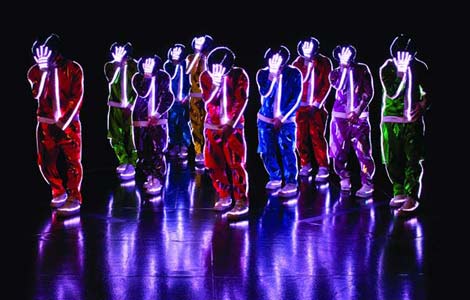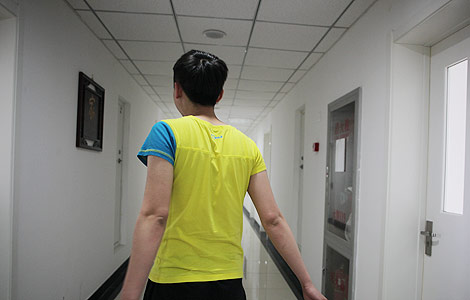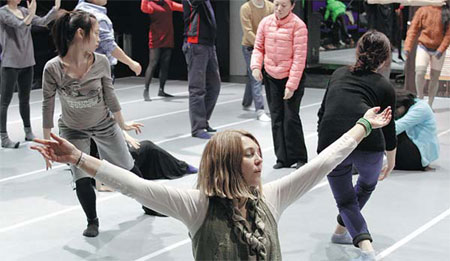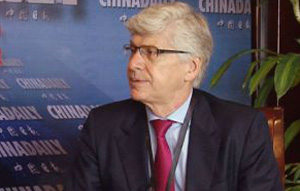Workshop exercises help break the ice, relieve anxiety
Updated: 2013-06-28 08:05
By Xu Jingxi (China Daily)
|
||||||||
|
Joan Wittig (center), a dance therapist in the United States, visited Beijing to offer professional training at a workshop hosted by Inspirees Institute of Creative Arts Therapy in March 2012. Provided to China Daily |

Although Wang Yuchi, a dance therapist in Guangzhou, didn't allow me to join a private group, she invited me to her free-of-charge public workshop, where participants go through the sessions of a dance therapy class except for case studies.
I met nine strangers in Wang's studio, which is located in a residential building. I took off my shoes, stepped onto the cartoon carpet rolled out on the floor of the apartment's living room, and was ready to see if I could dance my blues away.
We were first asked to design a pose to introduce ourselves. I made a V-for-victory gesture, which I often do unconsciously when I take a photo, and the other participants were required to repeat it after me. It's a bit embarrassing and we all laughed, but I have to admit that this creative way of self-introduction is effective to break the ice.
There were more creative activities for us to quickly build trust and understanding toward each other. We were divided into pairs. One walked across the room with his or her eyes closed, while his partner guided the way with touches instead of words.
It also gave me a chill in a good way to touch my partner's fingers with mine and try to feel each other's emotions through a "finger dance".
But the most memorable part was the "onion dance". Wang asked us to close our eyes, surrender our bodies to soft music and imagine ourselves as an onion that is peeling off its layers.
I broke the rule and opened my eyes to observe the other participants. A young woman caught my attention.
She waved her arms up and down as if she was lifting up her onion skins; she swirled across the room to peel off them layer by layer. She danced so hard that drops of sweat dripped from her forehead.
A smile gradually replaced the frown. Wang came over and whispered, "What do you see now?"
"Me as a free person," the young woman said with relief.
I interviewed the young woman after the workshop ended and discovered her story.
The 21-year-old college student, who declined to give her name, went to Wang's workshop hoping to dance away the "suffocating" expectations from her parents.
Having a brother who has an inborn cerebral injury, she is burdened with excessive control from her parents. They forced her to choose accounting studies instead of psychology, her interest, and also forbid her from having a relationship.
"I imagined I was peeling off all the restrictions from my parents when I did the 'onion dance' and my anxiety was gone," she told me.
Perhaps it's because I was thinking about the interview and writing in my mind that I didn't relax my body enough to feel the magic of dance therapy to reduce my pressure. Wang gave me an example to illustrate that dance therapy is more than stress relief.
"Many people come to a dance therapy class with an initial purpose of pressure release only, but they unconsciously show traumas through their body movements when they dance," Wang said.
"Their senses may have kept telling them, 'The trauma is gone, you're OK now,' but their body and storage of memories don't lie."
The therapist recalls an emotional breakout of one of her patients. While Wang helped the patient to relax her body and imagine she was going back to the past, the patient suddenly lost control of her body and shivered violently, murmuring, "Don't kill me."
After the patient was calmed down, she revealed to Wang that her mother had tried to abort her by taking aborticides twice. She thought she had gotten over the bad memory, but when she closed her eyes and relaxed her body as was told by Wang, she felt as if she were walking on a long, dark path which could lead her back to her mother's womb.
The case sounds unbelievable. In fact, many people doubt the effectiveness of dance therapy.
The country's medical institutions and universities are still cautious about the application of dance therapy and haven't done research on it as an independent subject.
Li Hua, director of Sun Yat-sen University's counseling center, doesn't plan to adopt dance therapy in her center yet. "Whether music and dance can work as therapy depends on the person's ability to understand the rhyme and body movement, so it may not work for most people," Li said.
Gu Nanyong - director of the teaching and research division of moral education at the Department of Social Sciences at Sun Yat-sen University's School of Education - echoed Li's sentiments. Because it's difficult to quantify dance therapy and other mind cures, even if a patient gets better, one can't be sure that dance therapy is the cause, Gu said.
Dance therapist Wang argued that statistics shouldn't be the only criterion to judge whether a mind cure is effective.
"How a patient feels, whether he or she feels any changes after undergoing the therapy also matters, especially when dance therapy emphasizes one's feelings and emotions," Wang said.
However, Tony Zhou from IICAT values statistics as a criterion for the effectiveness of dance therapy.
"We don't have an evaluation system in China for dance therapy exclusively. Apparently, for the time being, we can only adopt the system for psychotherapy on mental illnesses to assess the effectiveness of dance therapy," Zhou said.
"This is unfair for dance therapy because it is not only applied on the mentally ill but also 'sub-healthy' people who suffer emotional problems that are not serious enough to grow into a mental illness."
(China Daily USA 06/28/2013 page5)

 Visit aids 'trust-building process'
Visit aids 'trust-building process'
 King of Pop returns
King of Pop returns
 Crowds cheer Court decision on gay marriage
Crowds cheer Court decision on gay marriage
 Hiring index signals further job weakness
Hiring index signals further job weakness
 Dance becomes popular stress relief
Dance becomes popular stress relief
 Philippine, US start Naval exercise in S China Sea
Philippine, US start Naval exercise in S China Sea
 Supreme Court gay rights ruling celebrated across US
Supreme Court gay rights ruling celebrated across US
 Rudd returns as Australian PM after Gillard
Rudd returns as Australian PM after Gillard
Most Viewed
Editor's Picks

|

|

|

|

|

|
Today's Top News
Senate OKs immigration reform; hurdles remain
Snowden could request asylum in Russia: official
US collects Internet data on citizens
Boston bombing suspect accused in 4 deaths
816 elected in provincial leadership reshuffle
US adds to DPRK sanctions list
Chinese pros put trust in blogs
More Americans see Snowden as patriot: Poll
US Weekly

|

|







